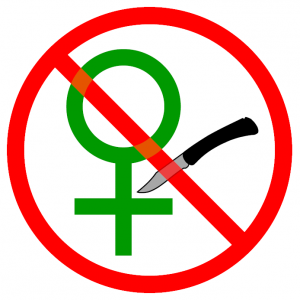fgm: a tradition that desperately needs to go
It is unfortunate that archaic traditions still proliferate in many parts of the world despite how much more socially progressive and politically conscious its inhabitants have become. Female Genital Mutilation (FGM) is a procedure often performed to ‘prepare’ girls for adulthood and marriage. You may ask: what exactly are the health benefits of such a tradition? And the answer? None. Only harm is caused.
Female circumcision is a social norm in many regions across Africa, Asia and the Middle East. Indeed, more than 125 million girls and women alive today have been cut, and it is estimated that more than three million girls are at risk of FGM. The motivations behind FGM are once again steeped in gendered conventions that involve inappropriate moralisation (by men!) on female sexuality. But wait! There may still be light at the end of this seemingly interminable tunnel.
Despite the various misconceptions that support the continuation of this horrendous practice, the condemnation of FGM by good ol’ UN Secretary-General Ban Ki-moon precipitates its decline, however glacial its pace. Instead, Ban champions alternative ways of signifying the passage into womanhood. New and humane rituals could be implemented that rely less on absurd, harmful methods and more on practical ones. For example, cultures that have previously affirmed womanhood with circumcision could adopt the newly developed models now used in Kenya and Tanzania whereby young girls spend a week away from their families to learn life skills. Now, this opinion may come across as much too radical for some of you, but independence and self-reliance seem awfully important and useful as a woman. More so than the loss of identity that survivors often grapple with as a result of FGM.
By a similar token, alternative procedures have been successfully adopted in Kenya where girls still get to experience all the elements of the traditional ceremony marking womanhood, minus the cutting. The girl will have her head shaved and is given a bracelet signifying her graduation. She will still experience wearing the traditional headdress symbolising her womanhood. She will be fully and proudly recognised as a woman by her community. And the best part is that instead of being violently cut and confronted with crippling pain and a litany of future psychological issues, milk is poured onto her thighs.
Nonetheless, there is also the problem of abandoning a ritual so imbedded into a culture without appearing disrespectful or completely out of line. Indeed, FGM does carry symbolic significance; however, it is just one that we are at odds with. Here, we are able to discern the importance of education in the community, particularly from the members of the community itself.
As project manager for Safe Kenya, a charity dedicated to eradicating FGM, Sarah Tenoi is well aware of the power of education and its capacity to instigate social change. Moreover, Tenoi is a Maasai woman from southwest Kenya and was circumcised when she was just 13 years old. As such, she was faced with the dilemma of opposing a long-standing tradition of her community whilst simultaneously not wishing to disrespect her culture and her elders. Her solution? Communication. Since 2008, Tenoi and her team have been tirelessly delivering education and raising awareness amongst her own people in their own languages about how to end FGM. The fact that decisions are then made in partnership as members of the community means that the change is not perceived as a threat to the culture.
While the effect on many cultures due to the growing awareness of the harms of FGM and the discouragement of its practice should not be overlooked, the cathartic relief that comes to the three million girls at risk of being cut outweighs all. The eradication of this ritual, which is understandably categorised as a violation of human rights, means that those three million girls will not have to face the myriad of physical and psychological issues that survivors experience today.
Inna Modja is one such survivor, having been subjected to FGM at the tender age of four according to her Malian community’s conventions. Modja hopes that the abandonment of such conventions would mean that girls will not be made to feel that they will ‘never become a woman because (they) had something missing’ or that cutting was telling them that they were ‘not good enough’. Too often do the pains of circumcision live on in the psyche of its survivors.
Ultimately, the force of education within the community, in conjunction with the development of alternative rites of passage, may soon mean the abandonment of FGM. This change is needed for the peace of mind of survivors to serve somewhat as an apology. It is a necessary one, albeit one that can never reconcile what they have suffered through. More importantly, progress is reassurance that such harm will never again befall girls. They will never be faced with misconceptions that they are unclean and inadequate for simply existing in their natural state.


